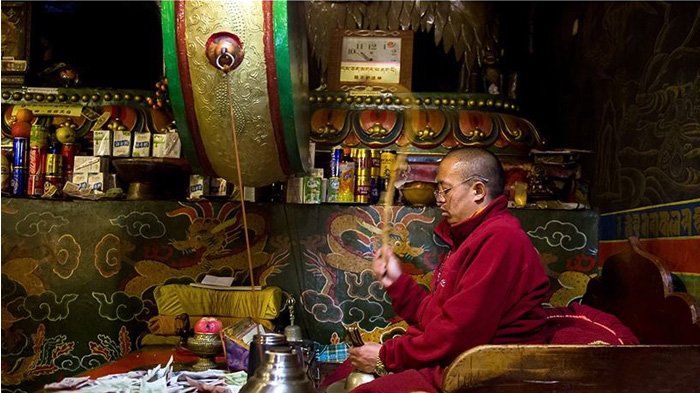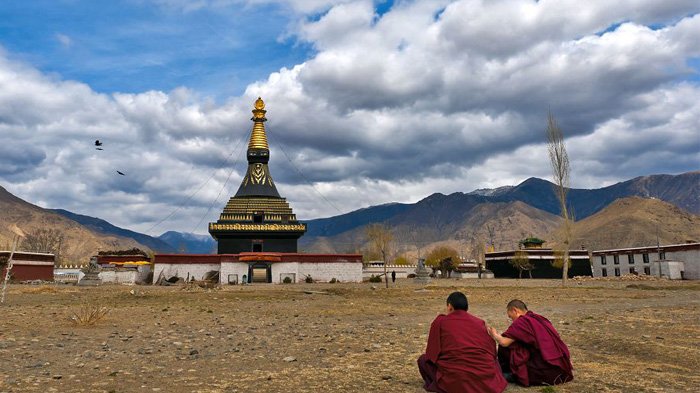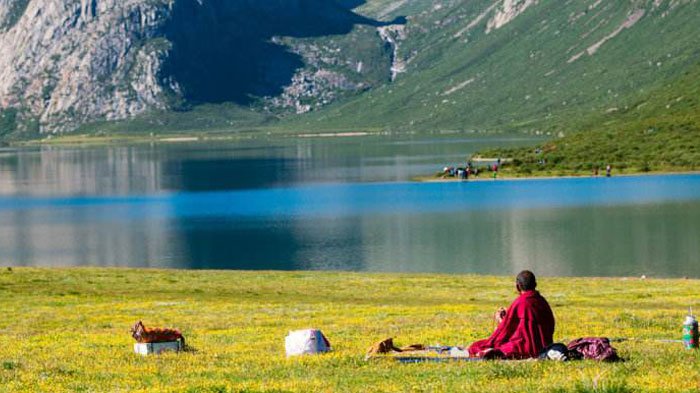
Your Ultimate Guide to Meditating in Tibet
Meditation is an ancient practice of mental training to induce deep states of concentration or a form of altered consciousness. Practically every religion has a form of meditation in the form of prayer, chanting, simple sitting & observing the breath, and work. Depending on the religion, the form and definition of meditation change.
 Buddhist Meditation
Buddhist Meditation
Eastern religions like Buddhism especially have a very strong background in meditation. In this article we will be primarily focusing on meditation techniques in Tibetan Buddhism, because Buddhism has numerous sects and traditions with each sect having its own rich tradition of meditation. In Tibetan Buddhism itself, there are different forms of meditation and some are even very advanced. Bewlows are the common types of meditation and the best places to meditate in Tibet
Dzogchen- a unique form of meditation in Nyingma sect
Dzogchen means“the great perfection” in Tibetan. Dzogchen is a form of advanced meditative techniques from the Nyingma school of Tibetan Buddhism. The principle of Dzogchen is to remain and be aware of the complete present. It is an abiding in the innate completeness of ourselves and hence realizing our Buddha nature that way.
 Meditating
Meditating
In Dzogchen the practitioner is taught to cut all unnecessary mental activity so he/she can realize the luminosity of their own true natures. In Dzogchen the practitioner is taught to calm their mind to such a degree that they are able to visualize the Buddhas and Bodhisattvas and use these visualizations on their path to enlightenment.
Dzogchen is considered to be one of the direct ways to realization and Buddhism but at the same time it is a very complex and difficult process. It requires the complete abandonment of desire, habits and tendencies so the mind becomes like an empty slate waiting to be written upon. It helps one recognize the pure and primordially aware nature of the mind. This awareness is called Rigpa in Tibetan.
How to do Dzogchen
Dzogchen meditation is done generally in silence. It is believed that only in silence can the mind shed away all its layers of social conditioning, thoughts and conceptual thinking. The meditation itself requires years of practice and patience. It involves sitting in silence in an alert meditative posture rather than slouching posture and paying attention to thoughts and mental formations as they arise. They key here is to objectively observe, only observe, but not interact with the mental arisings.
The benefits of doing Dzogchen are that with practice, the practitioner sees the way his/her thoughts are formed. They can catch mental tendencies and habits as they arise. Dzogchen is also extremely useful in learning to manage negative emotions like anger, grief, jealousy, etc. The practice is rooted in compassion whereby the practitioner observes all mental phenomena without judging or suppressing them. It is a state of open, loving awareness.
It is advised that practitioners interested in Dzogchen find a good teacher to guide them on this practice because there are many places where a teacher’s guidance is necessary.
Other simpler forms of meditation involves techniques like mantra recitation, visualization, loving-kindness, breath meditation etc.
Mantra recitation- a popular form of meditation
This involves, as the name suggests, meditation through the recitation of mantras. This is a very popular form of meditation and prayer in Tibet. When in Tibet, travellers might see many locals, particularly older people and monks constantly muttering prayers and sometimes counting beads on a mala or rosary. A very common mantra is the Om Mani Padme Hum mantra. It is used extensively by Tibetans. It has a very profound meaning but in short it means “The Jewel in the Lotus”, referring to the spirit of enlightenment.
 Meditating
Meditating
How to do mantra recitation
This form of meditation can be done anywhere. The practitioner has to thumb a mala of 108 beads while reciting the mantra they have chosen for themselves. The mantra can be recited silently or out loud. Each bead of the mala represents one recitation of the mantra.
The benefit of this is that it can be done anywhere, while travelling, while walking, etc. It doesn’t require any special training. It is also convenient for those who cannot spare much time for sitting practice. It is also believed that reciting mantras can ward away negative energy and attract positivity. The ideal mindset to doing the mantra recitation would be one of positivity, compassion and calmness. When one is meditating this way, it is recommended that they dedicate the merits obtained from reciting these mantras to all sentient beings including themselves.
Visualization- an advanced form of meditation
Visualization is another profound form of Tibetan meditation. This form involves visualizing a Buddhist deity or Buddha and meditating upon that image and upon the qualities possessed by the deity. The visualization is done in the mind rather than very literally.
How to do visualization
It is recommended for Buddhist practitioners to visualize a deity like the Bodhisattvas or any of the Buddhas. A common visualization is the six-armed Bodhisattva of compassion (Chenrezig). He represents universal compassion and loving-kindness. Another visualization is to visualize the Buddha, who represents the spirit of enlightenment and awareness. Some people visualize other figures like the Dalai Lama or Karmapa. It depends on the individual’s preference.
 Buddhist Meditation
Buddhist Meditation
This meditation involves focusing the image of the chosen deity in the mind’s eye on concentrating on this image. Alternatively, the practitioner can initially focus only on the image and once the concentration is gained, he/she can move on to contemplating the attributes and characteristics of the deity. Doing this often leads to some meditators experiencing a heightened meditative absorption and calmness. It also serves as basis for further developing the deity’s characteristics in one’s own self.
Loving-Kindness meditation- a distinct meditation on compassion
Loving-Kindness or Maitri (Sanskrit) or Jampa (Tibetan) refers to the feeling of compassion coupled with wisdom towards all phenomena. Tibetan Buddhism places heavy emphasis on loving-kindness. Loving-kindness is the primary attribute of Chenrezig Bodhisattva (Tibet's most famous Bodhisattva).
How to do Loving-Kindness meditation
In loving-kindness meditation, the practitioner calms his mind first and then projects or thinks thoughts of compassion towards himself and all beings. This meditation can be done anywhere.
 Meditating in Tibet
Meditating in Tibet
It is recommended that the practitioner starts off by projecting thoughts like “May I be happy” ,”May I be well”, “May I be free from Suffering” towards himself. Then once he feels stable enough in his meditation, he can progress on to a loved one, then a neutral object, then someone he dislikes and eventually to all sentient beings.
Doing this has many benefits. One will be kinder towards all things because loving-kindness comes under the realisation that all beings suffer, no matter what. One will be peaceful in the mind as loving thoughts replace thoughts of harm and hatred. It is said that practising loving-kindness causes the risk of high blood pressure and stress related disorders to go down.
Breath Meditation- simplest form of meditation
Breath meditation is a fairly simple and popular form of meditation. This involves observing one's breathing. The basis for this meditation technique is awareness and mindfulness. There are different ways of doing this meditation.
Different ways to do breath meditation
One may observe the sensation of the breath entering and leaving the body at the nostril or one may focus on the rise and fall of the chest or one may follow the breath cycle from beginning to end. The key is to gently focus the attention on the normal breathing. One should not forcefully breathe. When the attention wavers, one should notice this and gently bring it back to the breath without getting tensed by it.
 Meditating
Meditating
The benefits of doing this meditation involve increased awareness of bodily sensations, more attention span, lowering of anxiety as this technique can be used while having anxiety attacks (grounding oneself) and this form of meditation is also very relaxing as it is simple, can be done anywhere and does not involve too much thinking.
Meditation is a wonderful way to destress, cultivate mindfulness, cultivate mind-body awareness and compassion. It is a profound practice which has numerous health and psychological benefits. It is recommended that practitioners find a good meditation teacher to guide them. Most types of meditation can be done anywhere, so there is usually no need to go to a specific place or temple. For first timers, meditation requires patience, perseverance and discipline but the benefits are totally worth it.

Hi, I am a pretty and outgoing Tibetan girl. I have 6-year experience in guiding all kinds of Tibet tours.


.jpg)




0 Comment ON "Your Ultimate Guide to Meditating in Tibet"